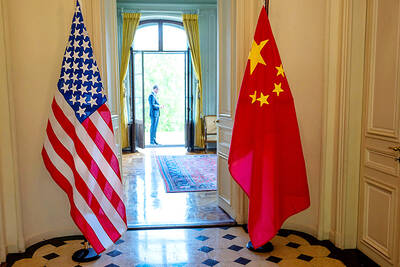Chinese social media giant Sina Weibo (微博) is making a push into foreign markets and is considering launching new products in different languages, a senior executive said, brushing off concerns over censorship and credibility.
The Twitter-style platform has long been prominent in China, known for its heavy censorship and Great Firewall, but it now wants to reach Chinese audiences overseas, Weibo Sports (微博體育) senior operations director Zhang Zhe said on the sidelines of Sports Connects, a sport-business conference in Dongguan, China.
“We want everyone in the Chinese-speaking world to use Weibo,” he added.
Sina Weibo is also looking into hiving off new, more niche products in different languages, including English, Zhang said.
TikTok (抖音), a short-form video-sharing app, proved wildly popular this year. Its Beijing-based creator, Bytedance Technology Co (字節跳動), this week announced a global tie-up with the NBA that would allow it to show highlights in several nations, including the US.
Sina “Weibo is a very comprehensively developed product. We not only have videos, we also have images, graphics, articles, even live streams. So we’ve got everything,” Zhang said. “We can’t just introduce [Sina] Weibo outside the country [China], because there’s already Twitter, Facebook. It doesn’t really make sense to compete directly, so if Weibo is going abroad, we think maybe if we have just one dedicated area of the product we can really cut into the market, like TikTok did.”
Zhang’s comments and the Bytedance announcement show how Chinese Internet companies, no longer content with the domestic market in the world’s most populous nation, are beginning to look overseas, but foreign expansion would bring added scrutiny for Sina Weibo, as Chinese social media are known not only for their censorship, but also fake news.
Sina Weibo has a team of more than 1,000 people verifying content on its network and says that it has strong editorial principles to keep its credibility intact.
“That’s not something we’re really worried about at the moment, because Weibo comes from Sina (新浪), which is a big media company with very strong principles like every news company in the world,” Zhang said when asked whether censorship would affect the image of any new products launched abroad. “We also have a huge team working on the content to make sure the news credibility is good, so we don’t think that’s an issue.”
Despite its ambitions overseas, China remains the main focus for Sina Weibo, which launched in 2009 and has more than 400 million monthly active users, making it China’s second-biggest platform behind Tencent Holdings Ltd’s (騰訊) WeChat (微信).

Real estate agent and property developer JSL Construction & Development Co (愛山林) led the average compensation rankings among companies listed on the Taiwan Stock Exchange (TWSE) last year, while contract chipmaker Taiwan Semiconductor Manufacturing Co (TSMC, 台積電) finished 14th. JSL Construction paid its employees total average compensation of NT$4.78 million (US$159,701), down 13.5 percent from a year earlier, but still ahead of the most profitable listed tech giants, including TSMC, TWSE data showed. Last year, the average compensation (which includes salary, overtime, bonuses and allowances) paid by TSMC rose 21.6 percent to reach about NT$3.33 million, lifting its ranking by 10 notches

Popular vape brands such as Geek Bar might get more expensive in the US — if you can find them at all. Shipments of vapes from China to the US ground to a near halt last month from a year ago, official data showed, hit by US President Donald Trump’s tariffs and a crackdown on unauthorized e-cigarettes in the world’s biggest market for smoking alternatives. That includes Geek Bar, a brand of flavored vapes that is not authorized to sell in the US, but which had been widely available due to porous import controls. One retailer, who asked not to be named, because

SEASONAL WEAKNESS: The combined revenue of the top 10 foundries fell 5.4%, but rush orders and China’s subsidies partially offset slowing demand Taiwan Semiconductor Manufacturing Co (TSMC, 台積電) further solidified its dominance in the global wafer foundry business in the first quarter of this year, remaining far ahead of its closest rival, Samsung Electronics Co, TrendForce Corp (集邦科技) said yesterday. TSMC posted US$25.52 billion in sales in the January-to-March period, down 5 percent from the previous quarter, but its market share rose from 67.1 percent the previous quarter to 67.6 percent, TrendForce said in a report. While smartphone-related wafer shipments declined in the first quarter due to seasonal factors, solid demand for artificial intelligence (AI) and high-performance computing (HPC) devices and urgent TV-related orders

MINERAL DIPLOMACY: The Chinese commerce ministry said it approved applications for the export of rare earths in a move that could help ease US-China trade tensions Chinese Vice Premier He Lifeng (何立峰) is today to meet a US delegation for talks in the UK, Beijing announced on Saturday amid a fragile truce in the trade dispute between the two powers. He is to visit the UK from yesterday to Friday at the invitation of the British government, the Chinese Ministry of Foreign Affairs said in a statement. He and US representatives are to cochair the first meeting of the US-China economic and trade consultation mechanism, it said. US President Donald Trump on Friday announced that a new round of trade talks with China would start in London beginning today,